Health sociology | Assessment 1
VerifiedAdded on 2022/10/08
|13
|6343
|30
Assignment
AI Summary
Contribute Materials
Your contribution can guide someone’s learning journey. Share your
documents today.
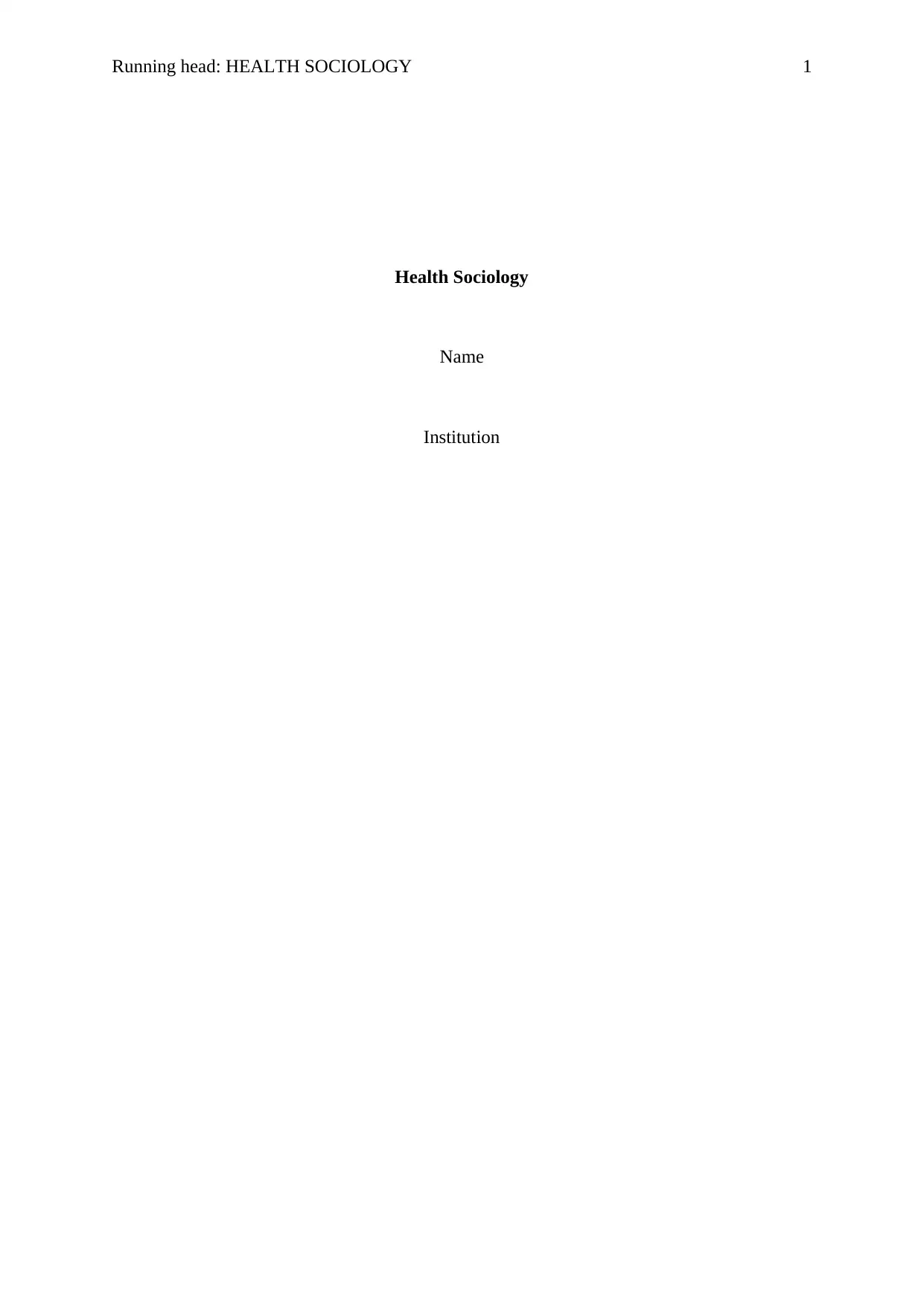
Running head: HEALTH SOCIOLOGY 1
Health Sociology
Name
Institution
Health Sociology
Name
Institution
Secure Best Marks with AI Grader
Need help grading? Try our AI Grader for instant feedback on your assignments.
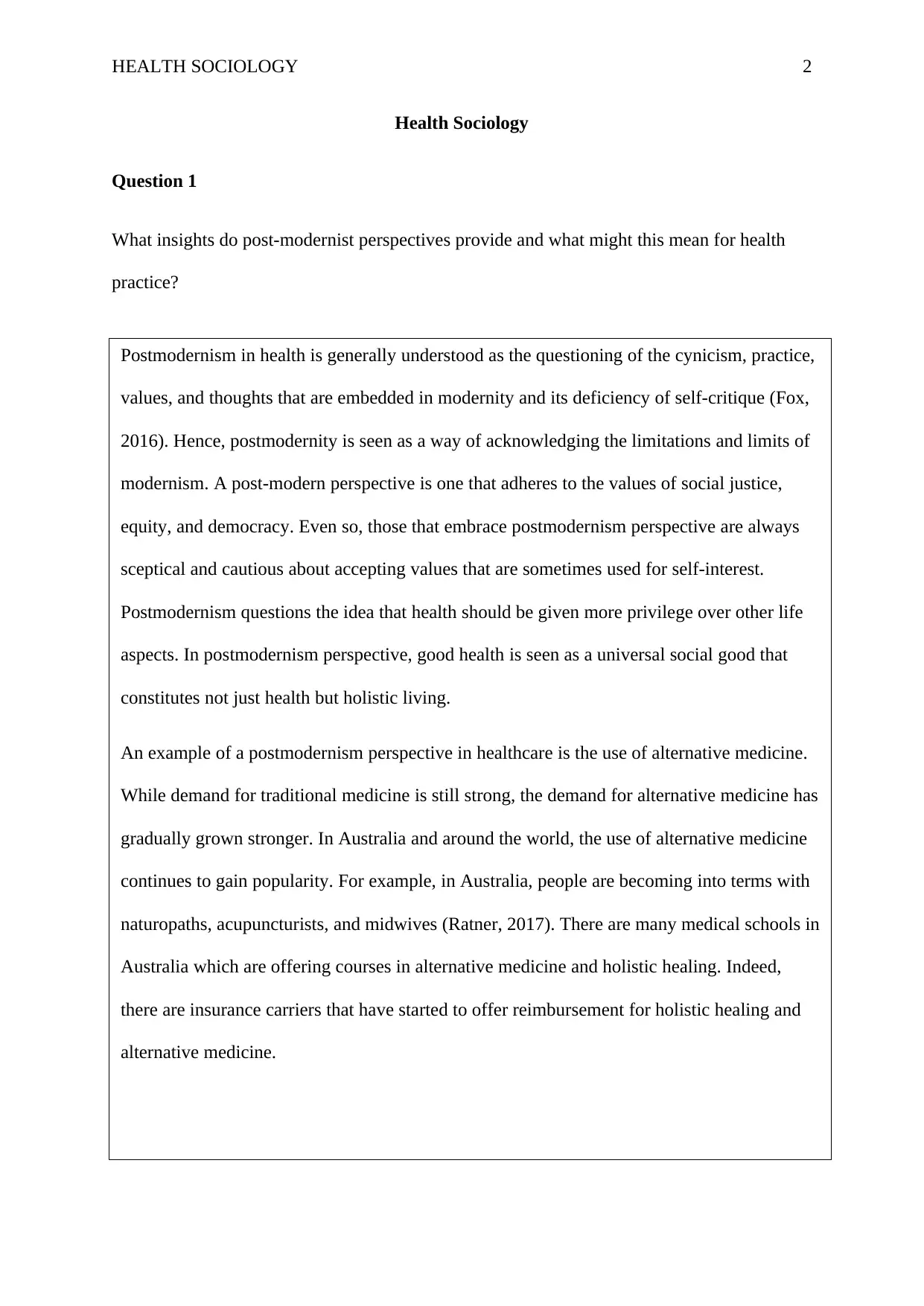
HEALTH SOCIOLOGY 2
Health Sociology
Question 1
What insights do post-modernist perspectives provide and what might this mean for health
practice?
Postmodernism in health is generally understood as the questioning of the cynicism, practice,
values, and thoughts that are embedded in modernity and its deficiency of self-critique (Fox,
2016). Hence, postmodernity is seen as a way of acknowledging the limitations and limits of
modernism. A post-modern perspective is one that adheres to the values of social justice,
equity, and democracy. Even so, those that embrace postmodernism perspective are always
sceptical and cautious about accepting values that are sometimes used for self-interest.
Postmodernism questions the idea that health should be given more privilege over other life
aspects. In postmodernism perspective, good health is seen as a universal social good that
constitutes not just health but holistic living.
An example of a postmodernism perspective in healthcare is the use of alternative medicine.
While demand for traditional medicine is still strong, the demand for alternative medicine has
gradually grown stronger. In Australia and around the world, the use of alternative medicine
continues to gain popularity. For example, in Australia, people are becoming into terms with
naturopaths, acupuncturists, and midwives (Ratner, 2017). There are many medical schools in
Australia which are offering courses in alternative medicine and holistic healing. Indeed,
there are insurance carriers that have started to offer reimbursement for holistic healing and
alternative medicine.
Health Sociology
Question 1
What insights do post-modernist perspectives provide and what might this mean for health
practice?
Postmodernism in health is generally understood as the questioning of the cynicism, practice,
values, and thoughts that are embedded in modernity and its deficiency of self-critique (Fox,
2016). Hence, postmodernity is seen as a way of acknowledging the limitations and limits of
modernism. A post-modern perspective is one that adheres to the values of social justice,
equity, and democracy. Even so, those that embrace postmodernism perspective are always
sceptical and cautious about accepting values that are sometimes used for self-interest.
Postmodernism questions the idea that health should be given more privilege over other life
aspects. In postmodernism perspective, good health is seen as a universal social good that
constitutes not just health but holistic living.
An example of a postmodernism perspective in healthcare is the use of alternative medicine.
While demand for traditional medicine is still strong, the demand for alternative medicine has
gradually grown stronger. In Australia and around the world, the use of alternative medicine
continues to gain popularity. For example, in Australia, people are becoming into terms with
naturopaths, acupuncturists, and midwives (Ratner, 2017). There are many medical schools in
Australia which are offering courses in alternative medicine and holistic healing. Indeed,
there are insurance carriers that have started to offer reimbursement for holistic healing and
alternative medicine.
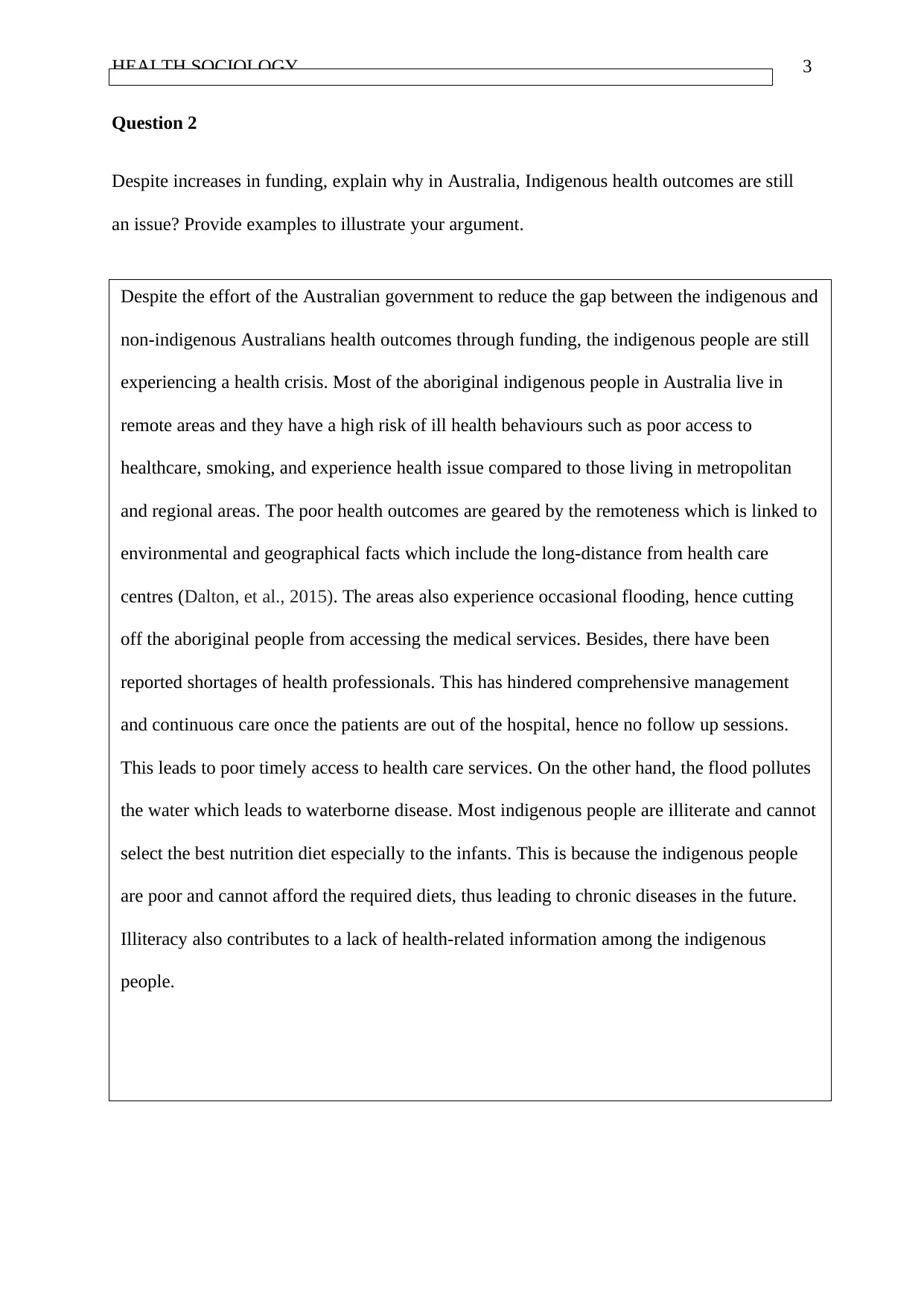
HEALTH SOCIOLOGY 3
Question 2
Despite increases in funding, explain why in Australia, Indigenous health outcomes are still
an issue? Provide examples to illustrate your argument.
Despite the effort of the Australian government to reduce the gap between the indigenous and
non-indigenous Australians health outcomes through funding, the indigenous people are still
experiencing a health crisis. Most of the aboriginal indigenous people in Australia live in
remote areas and they have a high risk of ill health behaviours such as poor access to
healthcare, smoking, and experience health issue compared to those living in metropolitan
and regional areas. The poor health outcomes are geared by the remoteness which is linked to
environmental and geographical facts which include the long-distance from health care
centres (Dalton, et al., 2015). The areas also experience occasional flooding, hence cutting
off the aboriginal people from accessing the medical services. Besides, there have been
reported shortages of health professionals. This has hindered comprehensive management
and continuous care once the patients are out of the hospital, hence no follow up sessions.
This leads to poor timely access to health care services. On the other hand, the flood pollutes
the water which leads to waterborne disease. Most indigenous people are illiterate and cannot
select the best nutrition diet especially to the infants. This is because the indigenous people
are poor and cannot afford the required diets, thus leading to chronic diseases in the future.
Illiteracy also contributes to a lack of health-related information among the indigenous
people.
Question 2
Despite increases in funding, explain why in Australia, Indigenous health outcomes are still
an issue? Provide examples to illustrate your argument.
Despite the effort of the Australian government to reduce the gap between the indigenous and
non-indigenous Australians health outcomes through funding, the indigenous people are still
experiencing a health crisis. Most of the aboriginal indigenous people in Australia live in
remote areas and they have a high risk of ill health behaviours such as poor access to
healthcare, smoking, and experience health issue compared to those living in metropolitan
and regional areas. The poor health outcomes are geared by the remoteness which is linked to
environmental and geographical facts which include the long-distance from health care
centres (Dalton, et al., 2015). The areas also experience occasional flooding, hence cutting
off the aboriginal people from accessing the medical services. Besides, there have been
reported shortages of health professionals. This has hindered comprehensive management
and continuous care once the patients are out of the hospital, hence no follow up sessions.
This leads to poor timely access to health care services. On the other hand, the flood pollutes
the water which leads to waterborne disease. Most indigenous people are illiterate and cannot
select the best nutrition diet especially to the infants. This is because the indigenous people
are poor and cannot afford the required diets, thus leading to chronic diseases in the future.
Illiteracy also contributes to a lack of health-related information among the indigenous
people.
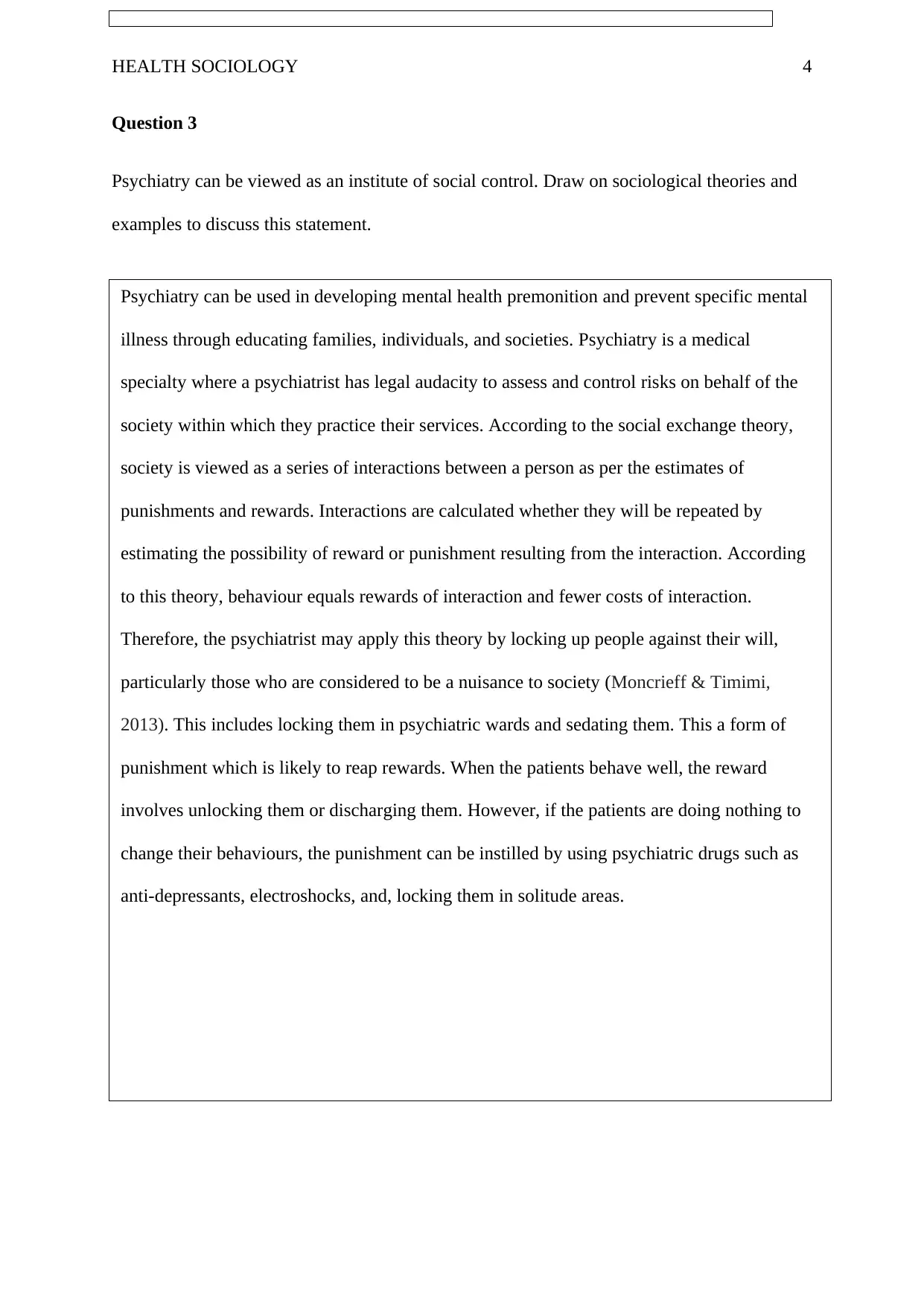
HEALTH SOCIOLOGY 4
Question 3
Psychiatry can be viewed as an institute of social control. Draw on sociological theories and
examples to discuss this statement.
Psychiatry can be used in developing mental health premonition and prevent specific mental
illness through educating families, individuals, and societies. Psychiatry is a medical
specialty where a psychiatrist has legal audacity to assess and control risks on behalf of the
society within which they practice their services. According to the social exchange theory,
society is viewed as a series of interactions between a person as per the estimates of
punishments and rewards. Interactions are calculated whether they will be repeated by
estimating the possibility of reward or punishment resulting from the interaction. According
to this theory, behaviour equals rewards of interaction and fewer costs of interaction.
Therefore, the psychiatrist may apply this theory by locking up people against their will,
particularly those who are considered to be a nuisance to society (Moncrieff & Timimi,
2013). This includes locking them in psychiatric wards and sedating them. This a form of
punishment which is likely to reap rewards. When the patients behave well, the reward
involves unlocking them or discharging them. However, if the patients are doing nothing to
change their behaviours, the punishment can be instilled by using psychiatric drugs such as
anti-depressants, electroshocks, and, locking them in solitude areas.
Question 3
Psychiatry can be viewed as an institute of social control. Draw on sociological theories and
examples to discuss this statement.
Psychiatry can be used in developing mental health premonition and prevent specific mental
illness through educating families, individuals, and societies. Psychiatry is a medical
specialty where a psychiatrist has legal audacity to assess and control risks on behalf of the
society within which they practice their services. According to the social exchange theory,
society is viewed as a series of interactions between a person as per the estimates of
punishments and rewards. Interactions are calculated whether they will be repeated by
estimating the possibility of reward or punishment resulting from the interaction. According
to this theory, behaviour equals rewards of interaction and fewer costs of interaction.
Therefore, the psychiatrist may apply this theory by locking up people against their will,
particularly those who are considered to be a nuisance to society (Moncrieff & Timimi,
2013). This includes locking them in psychiatric wards and sedating them. This a form of
punishment which is likely to reap rewards. When the patients behave well, the reward
involves unlocking them or discharging them. However, if the patients are doing nothing to
change their behaviours, the punishment can be instilled by using psychiatric drugs such as
anti-depressants, electroshocks, and, locking them in solitude areas.
Secure Best Marks with AI Grader
Need help grading? Try our AI Grader for instant feedback on your assignments.
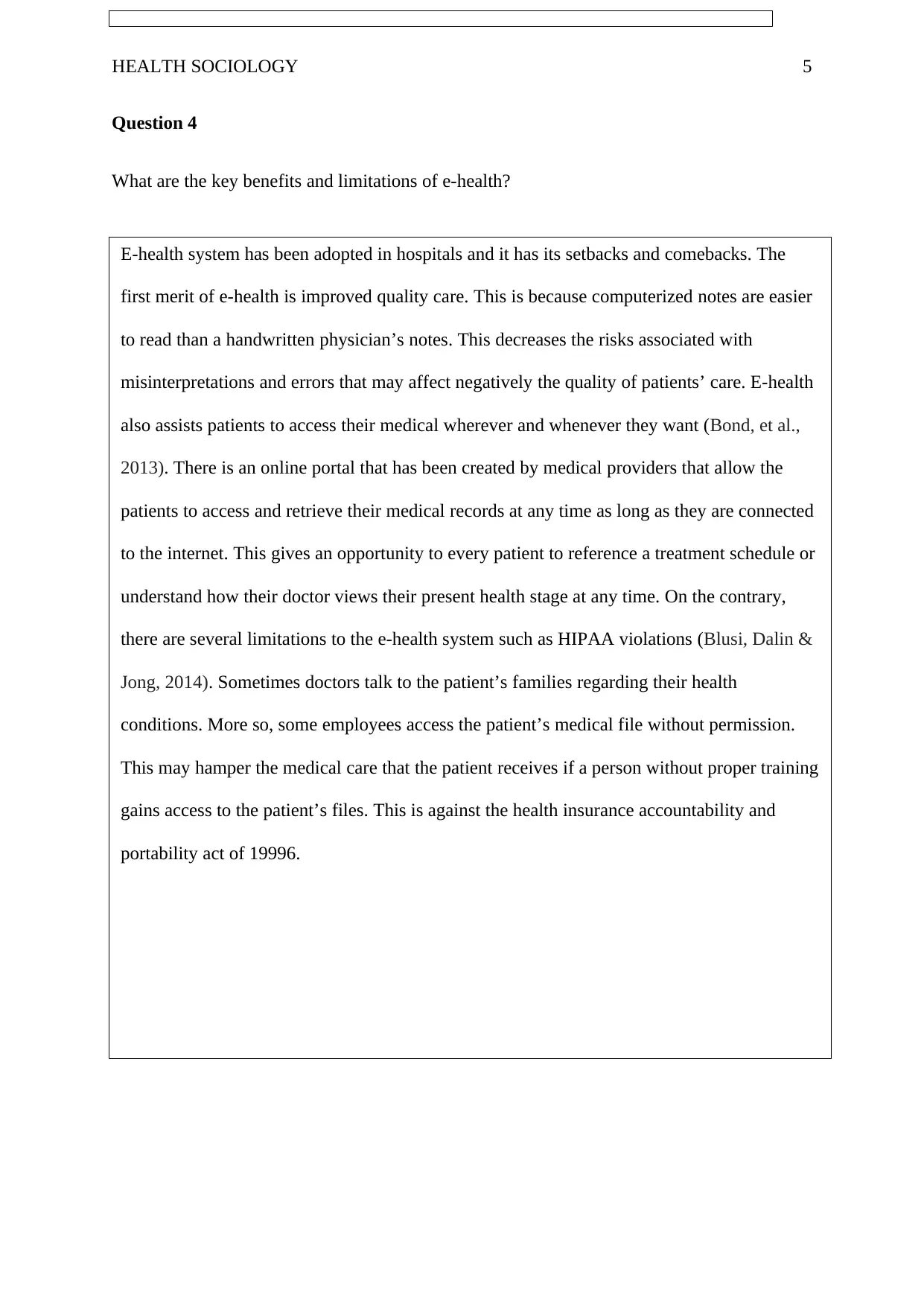
HEALTH SOCIOLOGY 5
Question 4
What are the key benefits and limitations of e-health?
E-health system has been adopted in hospitals and it has its setbacks and comebacks. The
first merit of e-health is improved quality care. This is because computerized notes are easier
to read than a handwritten physician’s notes. This decreases the risks associated with
misinterpretations and errors that may affect negatively the quality of patients’ care. E-health
also assists patients to access their medical wherever and whenever they want (Bond, et al.,
2013). There is an online portal that has been created by medical providers that allow the
patients to access and retrieve their medical records at any time as long as they are connected
to the internet. This gives an opportunity to every patient to reference a treatment schedule or
understand how their doctor views their present health stage at any time. On the contrary,
there are several limitations to the e-health system such as HIPAA violations (Blusi, Dalin &
Jong, 2014). Sometimes doctors talk to the patient’s families regarding their health
conditions. More so, some employees access the patient’s medical file without permission.
This may hamper the medical care that the patient receives if a person without proper training
gains access to the patient’s files. This is against the health insurance accountability and
portability act of 19996.
Question 4
What are the key benefits and limitations of e-health?
E-health system has been adopted in hospitals and it has its setbacks and comebacks. The
first merit of e-health is improved quality care. This is because computerized notes are easier
to read than a handwritten physician’s notes. This decreases the risks associated with
misinterpretations and errors that may affect negatively the quality of patients’ care. E-health
also assists patients to access their medical wherever and whenever they want (Bond, et al.,
2013). There is an online portal that has been created by medical providers that allow the
patients to access and retrieve their medical records at any time as long as they are connected
to the internet. This gives an opportunity to every patient to reference a treatment schedule or
understand how their doctor views their present health stage at any time. On the contrary,
there are several limitations to the e-health system such as HIPAA violations (Blusi, Dalin &
Jong, 2014). Sometimes doctors talk to the patient’s families regarding their health
conditions. More so, some employees access the patient’s medical file without permission.
This may hamper the medical care that the patient receives if a person without proper training
gains access to the patient’s files. This is against the health insurance accountability and
portability act of 19996.
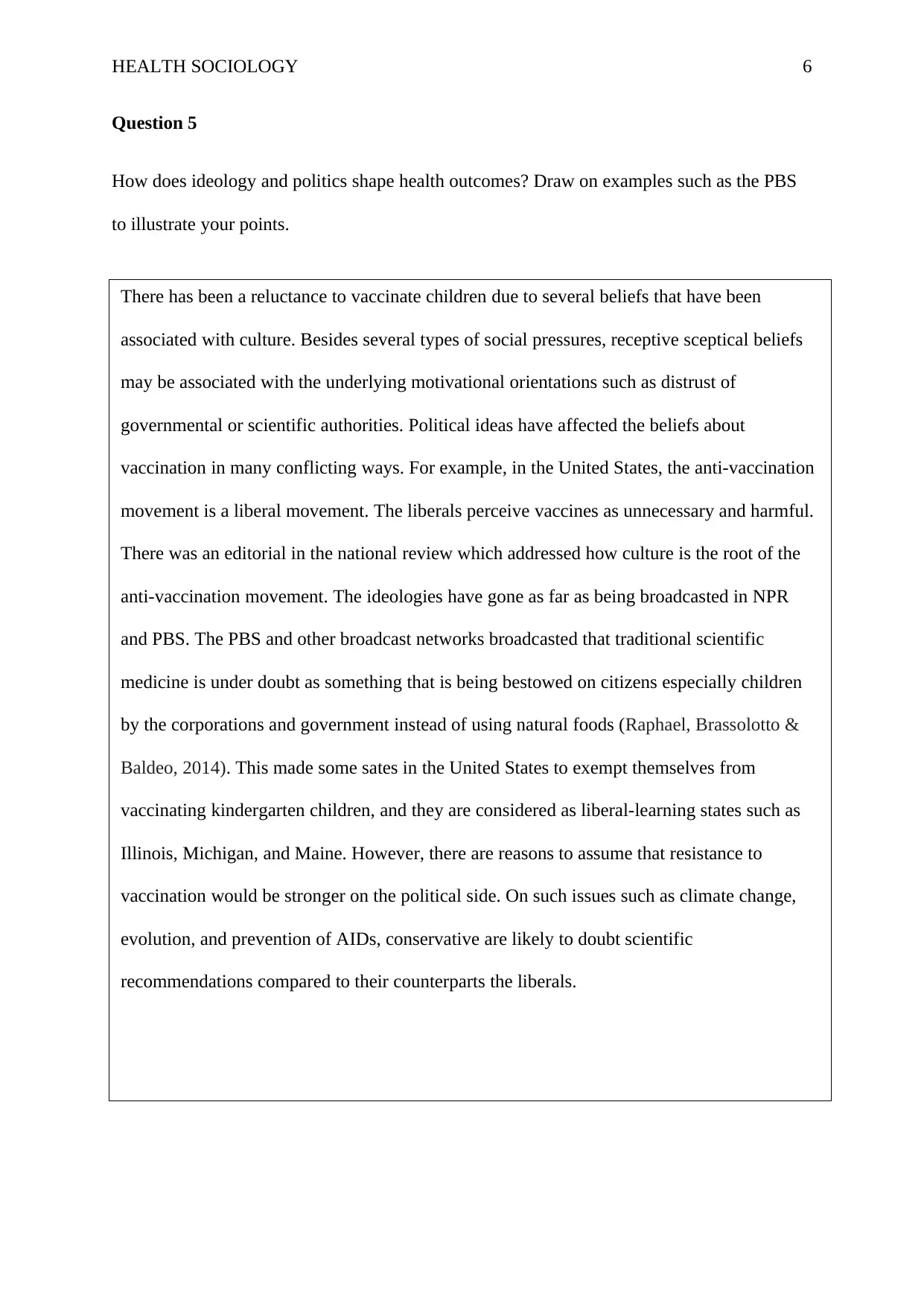
HEALTH SOCIOLOGY 6
Question 5
How does ideology and politics shape health outcomes? Draw on examples such as the PBS
to illustrate your points.
There has been a reluctance to vaccinate children due to several beliefs that have been
associated with culture. Besides several types of social pressures, receptive sceptical beliefs
may be associated with the underlying motivational orientations such as distrust of
governmental or scientific authorities. Political ideas have affected the beliefs about
vaccination in many conflicting ways. For example, in the United States, the anti-vaccination
movement is a liberal movement. The liberals perceive vaccines as unnecessary and harmful.
There was an editorial in the national review which addressed how culture is the root of the
anti-vaccination movement. The ideologies have gone as far as being broadcasted in NPR
and PBS. The PBS and other broadcast networks broadcasted that traditional scientific
medicine is under doubt as something that is being bestowed on citizens especially children
by the corporations and government instead of using natural foods (Raphael, Brassolotto &
Baldeo, 2014). This made some sates in the United States to exempt themselves from
vaccinating kindergarten children, and they are considered as liberal-learning states such as
Illinois, Michigan, and Maine. However, there are reasons to assume that resistance to
vaccination would be stronger on the political side. On such issues such as climate change,
evolution, and prevention of AIDs, conservative are likely to doubt scientific
recommendations compared to their counterparts the liberals.
Question 5
How does ideology and politics shape health outcomes? Draw on examples such as the PBS
to illustrate your points.
There has been a reluctance to vaccinate children due to several beliefs that have been
associated with culture. Besides several types of social pressures, receptive sceptical beliefs
may be associated with the underlying motivational orientations such as distrust of
governmental or scientific authorities. Political ideas have affected the beliefs about
vaccination in many conflicting ways. For example, in the United States, the anti-vaccination
movement is a liberal movement. The liberals perceive vaccines as unnecessary and harmful.
There was an editorial in the national review which addressed how culture is the root of the
anti-vaccination movement. The ideologies have gone as far as being broadcasted in NPR
and PBS. The PBS and other broadcast networks broadcasted that traditional scientific
medicine is under doubt as something that is being bestowed on citizens especially children
by the corporations and government instead of using natural foods (Raphael, Brassolotto &
Baldeo, 2014). This made some sates in the United States to exempt themselves from
vaccinating kindergarten children, and they are considered as liberal-learning states such as
Illinois, Michigan, and Maine. However, there are reasons to assume that resistance to
vaccination would be stronger on the political side. On such issues such as climate change,
evolution, and prevention of AIDs, conservative are likely to doubt scientific
recommendations compared to their counterparts the liberals.
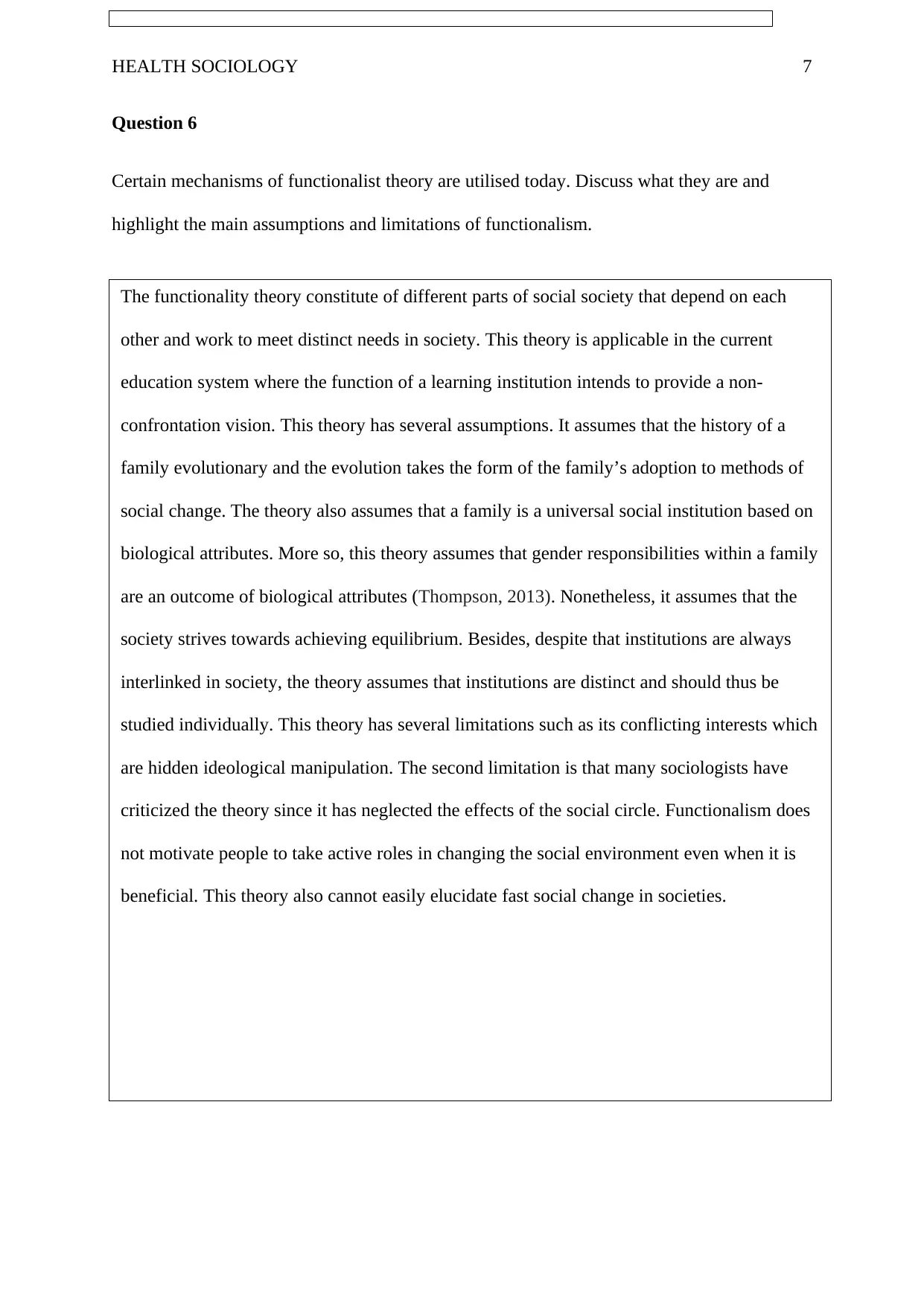
HEALTH SOCIOLOGY 7
Question 6
Certain mechanisms of functionalist theory are utilised today. Discuss what they are and
highlight the main assumptions and limitations of functionalism.
The functionality theory constitute of different parts of social society that depend on each
other and work to meet distinct needs in society. This theory is applicable in the current
education system where the function of a learning institution intends to provide a non-
confrontation vision. This theory has several assumptions. It assumes that the history of a
family evolutionary and the evolution takes the form of the family’s adoption to methods of
social change. The theory also assumes that a family is a universal social institution based on
biological attributes. More so, this theory assumes that gender responsibilities within a family
are an outcome of biological attributes (Thompson, 2013). Nonetheless, it assumes that the
society strives towards achieving equilibrium. Besides, despite that institutions are always
interlinked in society, the theory assumes that institutions are distinct and should thus be
studied individually. This theory has several limitations such as its conflicting interests which
are hidden ideological manipulation. The second limitation is that many sociologists have
criticized the theory since it has neglected the effects of the social circle. Functionalism does
not motivate people to take active roles in changing the social environment even when it is
beneficial. This theory also cannot easily elucidate fast social change in societies.
Question 6
Certain mechanisms of functionalist theory are utilised today. Discuss what they are and
highlight the main assumptions and limitations of functionalism.
The functionality theory constitute of different parts of social society that depend on each
other and work to meet distinct needs in society. This theory is applicable in the current
education system where the function of a learning institution intends to provide a non-
confrontation vision. This theory has several assumptions. It assumes that the history of a
family evolutionary and the evolution takes the form of the family’s adoption to methods of
social change. The theory also assumes that a family is a universal social institution based on
biological attributes. More so, this theory assumes that gender responsibilities within a family
are an outcome of biological attributes (Thompson, 2013). Nonetheless, it assumes that the
society strives towards achieving equilibrium. Besides, despite that institutions are always
interlinked in society, the theory assumes that institutions are distinct and should thus be
studied individually. This theory has several limitations such as its conflicting interests which
are hidden ideological manipulation. The second limitation is that many sociologists have
criticized the theory since it has neglected the effects of the social circle. Functionalism does
not motivate people to take active roles in changing the social environment even when it is
beneficial. This theory also cannot easily elucidate fast social change in societies.
Paraphrase This Document
Need a fresh take? Get an instant paraphrase of this document with our AI Paraphraser
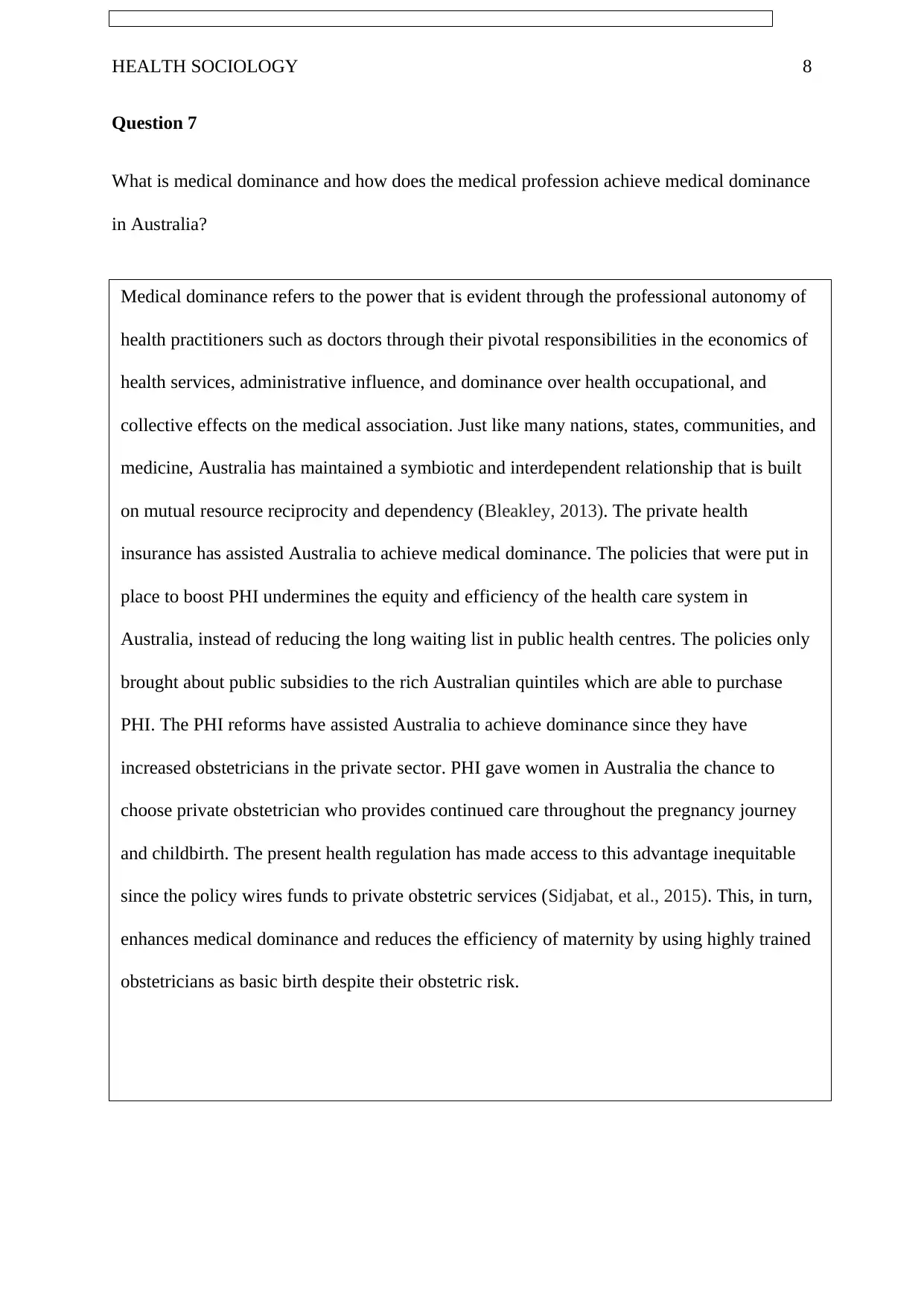
HEALTH SOCIOLOGY 8
Question 7
What is medical dominance and how does the medical profession achieve medical dominance
in Australia?
Medical dominance refers to the power that is evident through the professional autonomy of
health practitioners such as doctors through their pivotal responsibilities in the economics of
health services, administrative influence, and dominance over health occupational, and
collective effects on the medical association. Just like many nations, states, communities, and
medicine, Australia has maintained a symbiotic and interdependent relationship that is built
on mutual resource reciprocity and dependency (Bleakley, 2013). The private health
insurance has assisted Australia to achieve medical dominance. The policies that were put in
place to boost PHI undermines the equity and efficiency of the health care system in
Australia, instead of reducing the long waiting list in public health centres. The policies only
brought about public subsidies to the rich Australian quintiles which are able to purchase
PHI. The PHI reforms have assisted Australia to achieve dominance since they have
increased obstetricians in the private sector. PHI gave women in Australia the chance to
choose private obstetrician who provides continued care throughout the pregnancy journey
and childbirth. The present health regulation has made access to this advantage inequitable
since the policy wires funds to private obstetric services (Sidjabat, et al., 2015). This, in turn,
enhances medical dominance and reduces the efficiency of maternity by using highly trained
obstetricians as basic birth despite their obstetric risk.
Question 7
What is medical dominance and how does the medical profession achieve medical dominance
in Australia?
Medical dominance refers to the power that is evident through the professional autonomy of
health practitioners such as doctors through their pivotal responsibilities in the economics of
health services, administrative influence, and dominance over health occupational, and
collective effects on the medical association. Just like many nations, states, communities, and
medicine, Australia has maintained a symbiotic and interdependent relationship that is built
on mutual resource reciprocity and dependency (Bleakley, 2013). The private health
insurance has assisted Australia to achieve medical dominance. The policies that were put in
place to boost PHI undermines the equity and efficiency of the health care system in
Australia, instead of reducing the long waiting list in public health centres. The policies only
brought about public subsidies to the rich Australian quintiles which are able to purchase
PHI. The PHI reforms have assisted Australia to achieve dominance since they have
increased obstetricians in the private sector. PHI gave women in Australia the chance to
choose private obstetrician who provides continued care throughout the pregnancy journey
and childbirth. The present health regulation has made access to this advantage inequitable
since the policy wires funds to private obstetric services (Sidjabat, et al., 2015). This, in turn,
enhances medical dominance and reduces the efficiency of maternity by using highly trained
obstetricians as basic birth despite their obstetric risk.
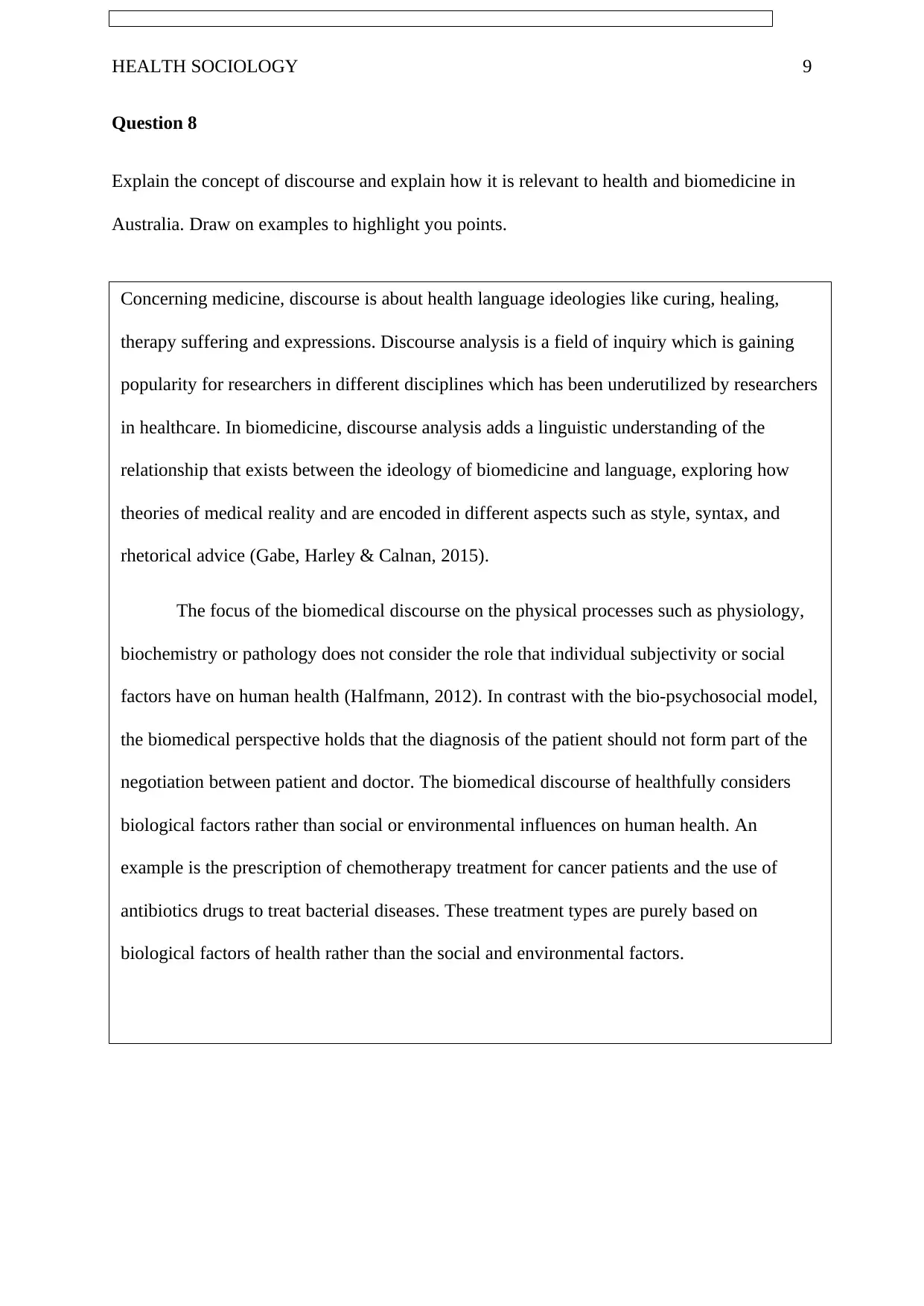
HEALTH SOCIOLOGY 9
Question 8
Explain the concept of discourse and explain how it is relevant to health and biomedicine in
Australia. Draw on examples to highlight you points.
Concerning medicine, discourse is about health language ideologies like curing, healing,
therapy suffering and expressions. Discourse analysis is a field of inquiry which is gaining
popularity for researchers in different disciplines which has been underutilized by researchers
in healthcare. In biomedicine, discourse analysis adds a linguistic understanding of the
relationship that exists between the ideology of biomedicine and language, exploring how
theories of medical reality and are encoded in different aspects such as style, syntax, and
rhetorical advice (Gabe, Harley & Calnan, 2015).
The focus of the biomedical discourse on the physical processes such as physiology,
biochemistry or pathology does not consider the role that individual subjectivity or social
factors have on human health (Halfmann, 2012). In contrast with the bio-psychosocial model,
the biomedical perspective holds that the diagnosis of the patient should not form part of the
negotiation between patient and doctor. The biomedical discourse of healthfully considers
biological factors rather than social or environmental influences on human health. An
example is the prescription of chemotherapy treatment for cancer patients and the use of
antibiotics drugs to treat bacterial diseases. These treatment types are purely based on
biological factors of health rather than the social and environmental factors.
Question 8
Explain the concept of discourse and explain how it is relevant to health and biomedicine in
Australia. Draw on examples to highlight you points.
Concerning medicine, discourse is about health language ideologies like curing, healing,
therapy suffering and expressions. Discourse analysis is a field of inquiry which is gaining
popularity for researchers in different disciplines which has been underutilized by researchers
in healthcare. In biomedicine, discourse analysis adds a linguistic understanding of the
relationship that exists between the ideology of biomedicine and language, exploring how
theories of medical reality and are encoded in different aspects such as style, syntax, and
rhetorical advice (Gabe, Harley & Calnan, 2015).
The focus of the biomedical discourse on the physical processes such as physiology,
biochemistry or pathology does not consider the role that individual subjectivity or social
factors have on human health (Halfmann, 2012). In contrast with the bio-psychosocial model,
the biomedical perspective holds that the diagnosis of the patient should not form part of the
negotiation between patient and doctor. The biomedical discourse of healthfully considers
biological factors rather than social or environmental influences on human health. An
example is the prescription of chemotherapy treatment for cancer patients and the use of
antibiotics drugs to treat bacterial diseases. These treatment types are purely based on
biological factors of health rather than the social and environmental factors.
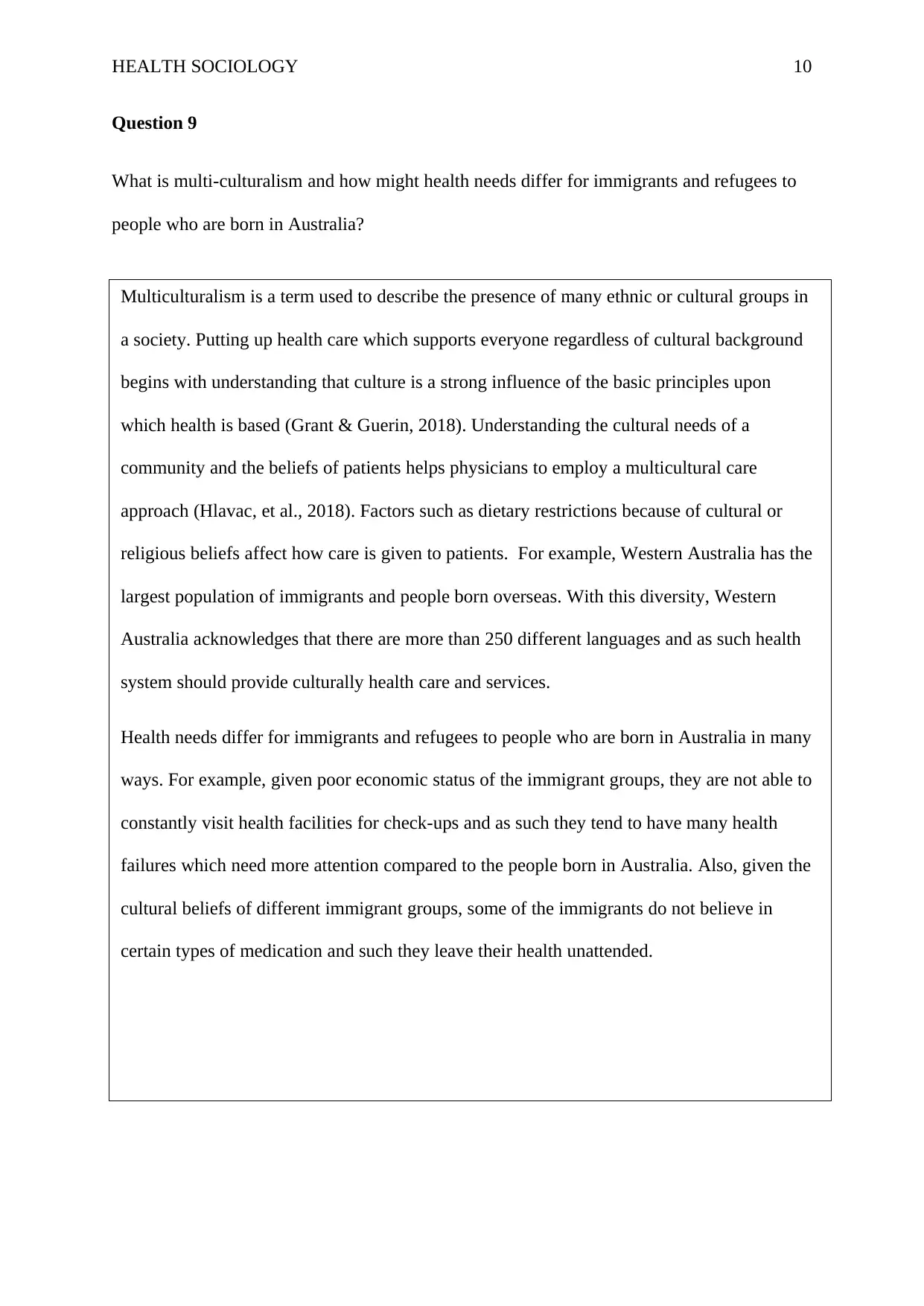
HEALTH SOCIOLOGY 10
Question 9
What is multi-culturalism and how might health needs differ for immigrants and refugees to
people who are born in Australia?
Multiculturalism is a term used to describe the presence of many ethnic or cultural groups in
a society. Putting up health care which supports everyone regardless of cultural background
begins with understanding that culture is a strong influence of the basic principles upon
which health is based (Grant & Guerin, 2018). Understanding the cultural needs of a
community and the beliefs of patients helps physicians to employ a multicultural care
approach (Hlavac, et al., 2018). Factors such as dietary restrictions because of cultural or
religious beliefs affect how care is given to patients. For example, Western Australia has the
largest population of immigrants and people born overseas. With this diversity, Western
Australia acknowledges that there are more than 250 different languages and as such health
system should provide culturally health care and services.
Health needs differ for immigrants and refugees to people who are born in Australia in many
ways. For example, given poor economic status of the immigrant groups, they are not able to
constantly visit health facilities for check-ups and as such they tend to have many health
failures which need more attention compared to the people born in Australia. Also, given the
cultural beliefs of different immigrant groups, some of the immigrants do not believe in
certain types of medication and such they leave their health unattended.
Question 9
What is multi-culturalism and how might health needs differ for immigrants and refugees to
people who are born in Australia?
Multiculturalism is a term used to describe the presence of many ethnic or cultural groups in
a society. Putting up health care which supports everyone regardless of cultural background
begins with understanding that culture is a strong influence of the basic principles upon
which health is based (Grant & Guerin, 2018). Understanding the cultural needs of a
community and the beliefs of patients helps physicians to employ a multicultural care
approach (Hlavac, et al., 2018). Factors such as dietary restrictions because of cultural or
religious beliefs affect how care is given to patients. For example, Western Australia has the
largest population of immigrants and people born overseas. With this diversity, Western
Australia acknowledges that there are more than 250 different languages and as such health
system should provide culturally health care and services.
Health needs differ for immigrants and refugees to people who are born in Australia in many
ways. For example, given poor economic status of the immigrant groups, they are not able to
constantly visit health facilities for check-ups and as such they tend to have many health
failures which need more attention compared to the people born in Australia. Also, given the
cultural beliefs of different immigrant groups, some of the immigrants do not believe in
certain types of medication and such they leave their health unattended.
Secure Best Marks with AI Grader
Need help grading? Try our AI Grader for instant feedback on your assignments.
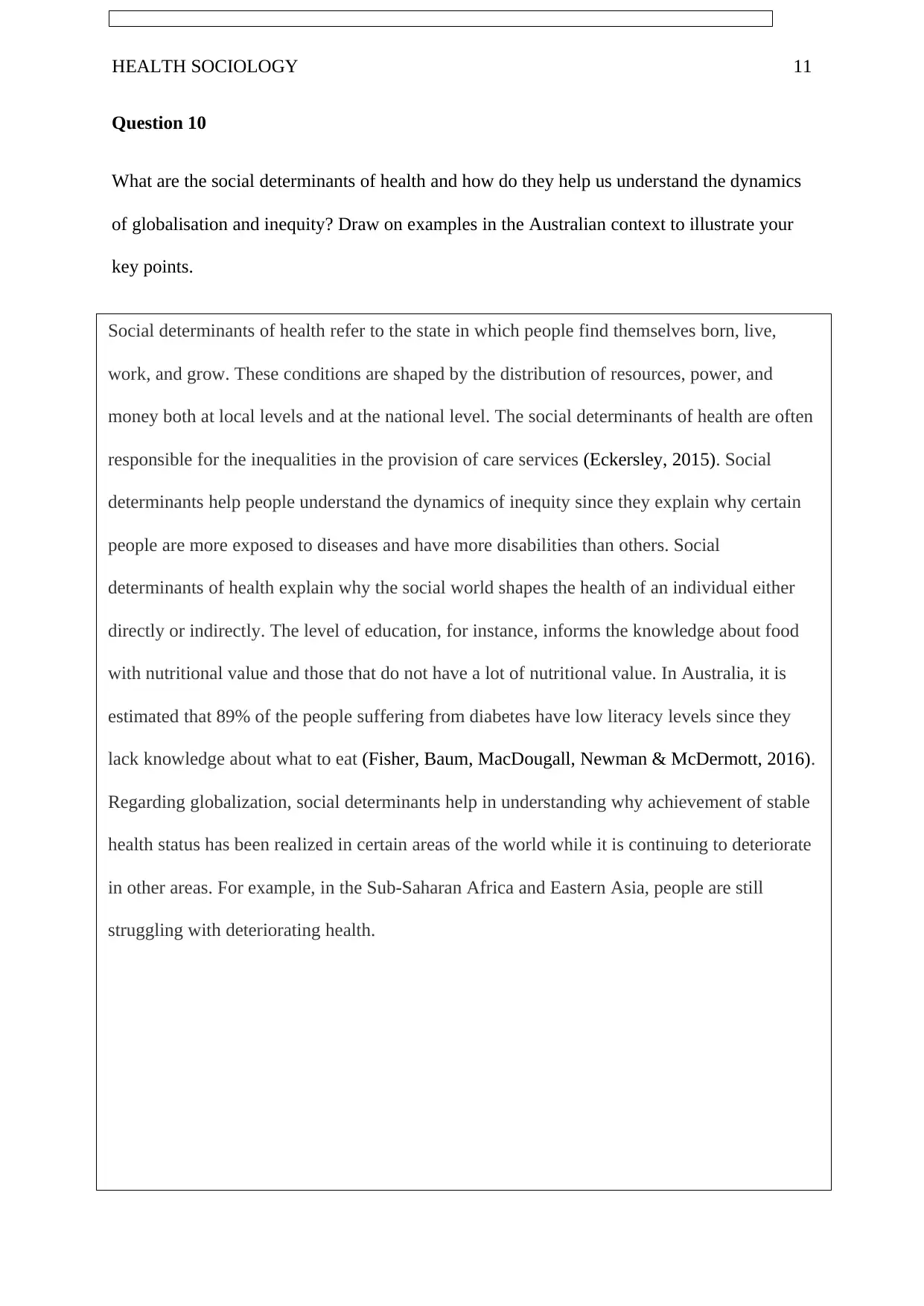
HEALTH SOCIOLOGY 11
Question 10
What are the social determinants of health and how do they help us understand the dynamics
of globalisation and inequity? Draw on examples in the Australian context to illustrate your
key points.
Social determinants of health refer to the state in which people find themselves born, live,
work, and grow. These conditions are shaped by the distribution of resources, power, and
money both at local levels and at the national level. The social determinants of health are often
responsible for the inequalities in the provision of care services (Eckersley, 2015). Social
determinants help people understand the dynamics of inequity since they explain why certain
people are more exposed to diseases and have more disabilities than others. Social
determinants of health explain why the social world shapes the health of an individual either
directly or indirectly. The level of education, for instance, informs the knowledge about food
with nutritional value and those that do not have a lot of nutritional value. In Australia, it is
estimated that 89% of the people suffering from diabetes have low literacy levels since they
lack knowledge about what to eat (Fisher, Baum, MacDougall, Newman & McDermott, 2016).
Regarding globalization, social determinants help in understanding why achievement of stable
health status has been realized in certain areas of the world while it is continuing to deteriorate
in other areas. For example, in the Sub-Saharan Africa and Eastern Asia, people are still
struggling with deteriorating health.
Question 10
What are the social determinants of health and how do they help us understand the dynamics
of globalisation and inequity? Draw on examples in the Australian context to illustrate your
key points.
Social determinants of health refer to the state in which people find themselves born, live,
work, and grow. These conditions are shaped by the distribution of resources, power, and
money both at local levels and at the national level. The social determinants of health are often
responsible for the inequalities in the provision of care services (Eckersley, 2015). Social
determinants help people understand the dynamics of inequity since they explain why certain
people are more exposed to diseases and have more disabilities than others. Social
determinants of health explain why the social world shapes the health of an individual either
directly or indirectly. The level of education, for instance, informs the knowledge about food
with nutritional value and those that do not have a lot of nutritional value. In Australia, it is
estimated that 89% of the people suffering from diabetes have low literacy levels since they
lack knowledge about what to eat (Fisher, Baum, MacDougall, Newman & McDermott, 2016).
Regarding globalization, social determinants help in understanding why achievement of stable
health status has been realized in certain areas of the world while it is continuing to deteriorate
in other areas. For example, in the Sub-Saharan Africa and Eastern Asia, people are still
struggling with deteriorating health.
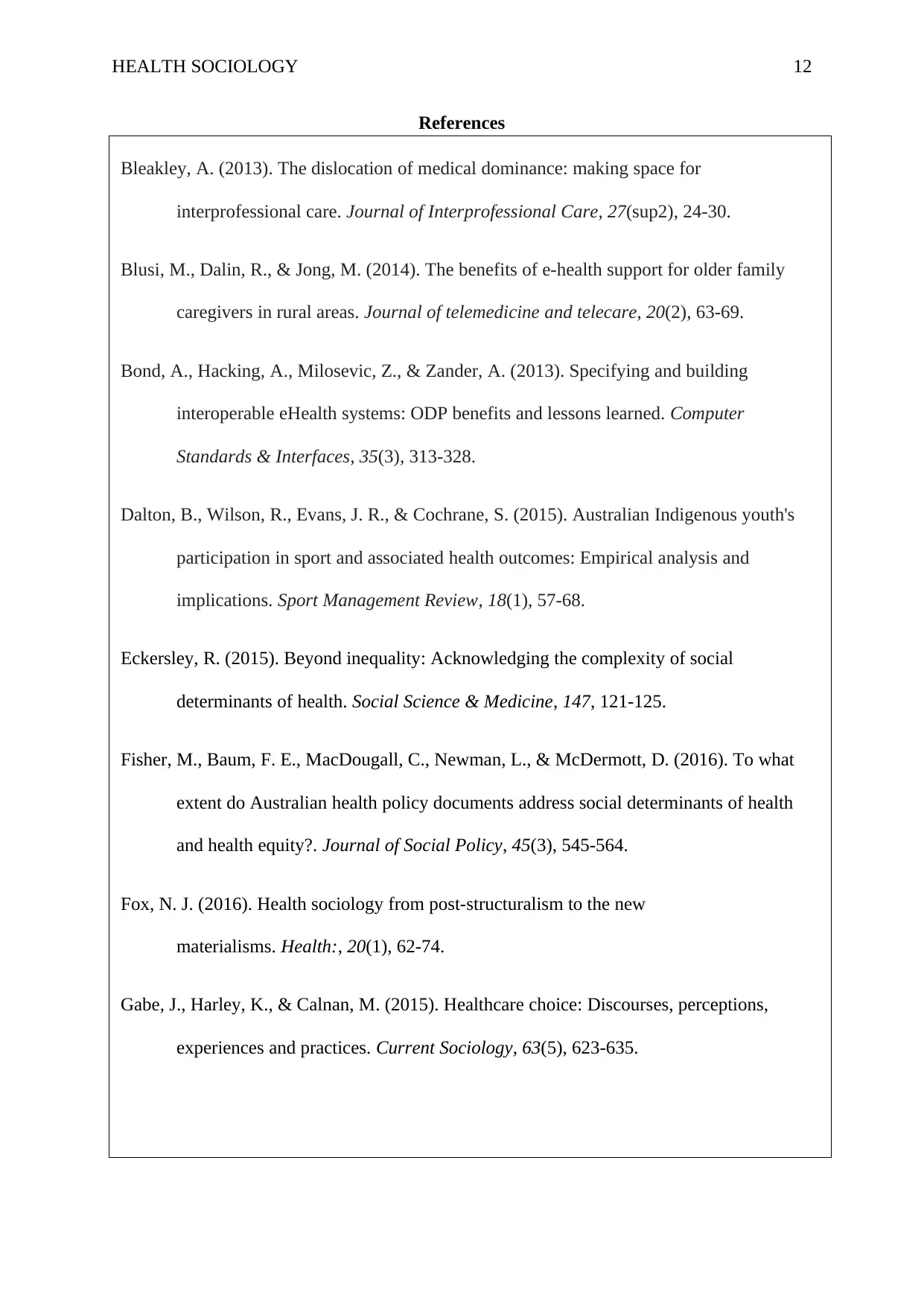
HEALTH SOCIOLOGY 12
References
Bleakley, A. (2013). The dislocation of medical dominance: making space for
interprofessional care. Journal of Interprofessional Care, 27(sup2), 24-30.
Blusi, M., Dalin, R., & Jong, M. (2014). The benefits of e-health support for older family
caregivers in rural areas. Journal of telemedicine and telecare, 20(2), 63-69.
Bond, A., Hacking, A., Milosevic, Z., & Zander, A. (2013). Specifying and building
interoperable eHealth systems: ODP benefits and lessons learned. Computer
Standards & Interfaces, 35(3), 313-328.
Dalton, B., Wilson, R., Evans, J. R., & Cochrane, S. (2015). Australian Indigenous youth's
participation in sport and associated health outcomes: Empirical analysis and
implications. Sport Management Review, 18(1), 57-68.
Eckersley, R. (2015). Beyond inequality: Acknowledging the complexity of social
determinants of health. Social Science & Medicine, 147, 121-125.
Fisher, M., Baum, F. E., MacDougall, C., Newman, L., & McDermott, D. (2016). To what
extent do Australian health policy documents address social determinants of health
and health equity?. Journal of Social Policy, 45(3), 545-564.
Fox, N. J. (2016). Health sociology from post-structuralism to the new
materialisms. Health:, 20(1), 62-74.
Gabe, J., Harley, K., & Calnan, M. (2015). Healthcare choice: Discourses, perceptions,
experiences and practices. Current Sociology, 63(5), 623-635.
References
Bleakley, A. (2013). The dislocation of medical dominance: making space for
interprofessional care. Journal of Interprofessional Care, 27(sup2), 24-30.
Blusi, M., Dalin, R., & Jong, M. (2014). The benefits of e-health support for older family
caregivers in rural areas. Journal of telemedicine and telecare, 20(2), 63-69.
Bond, A., Hacking, A., Milosevic, Z., & Zander, A. (2013). Specifying and building
interoperable eHealth systems: ODP benefits and lessons learned. Computer
Standards & Interfaces, 35(3), 313-328.
Dalton, B., Wilson, R., Evans, J. R., & Cochrane, S. (2015). Australian Indigenous youth's
participation in sport and associated health outcomes: Empirical analysis and
implications. Sport Management Review, 18(1), 57-68.
Eckersley, R. (2015). Beyond inequality: Acknowledging the complexity of social
determinants of health. Social Science & Medicine, 147, 121-125.
Fisher, M., Baum, F. E., MacDougall, C., Newman, L., & McDermott, D. (2016). To what
extent do Australian health policy documents address social determinants of health
and health equity?. Journal of Social Policy, 45(3), 545-564.
Fox, N. J. (2016). Health sociology from post-structuralism to the new
materialisms. Health:, 20(1), 62-74.
Gabe, J., Harley, K., & Calnan, M. (2015). Healthcare choice: Discourses, perceptions,
experiences and practices. Current Sociology, 63(5), 623-635.
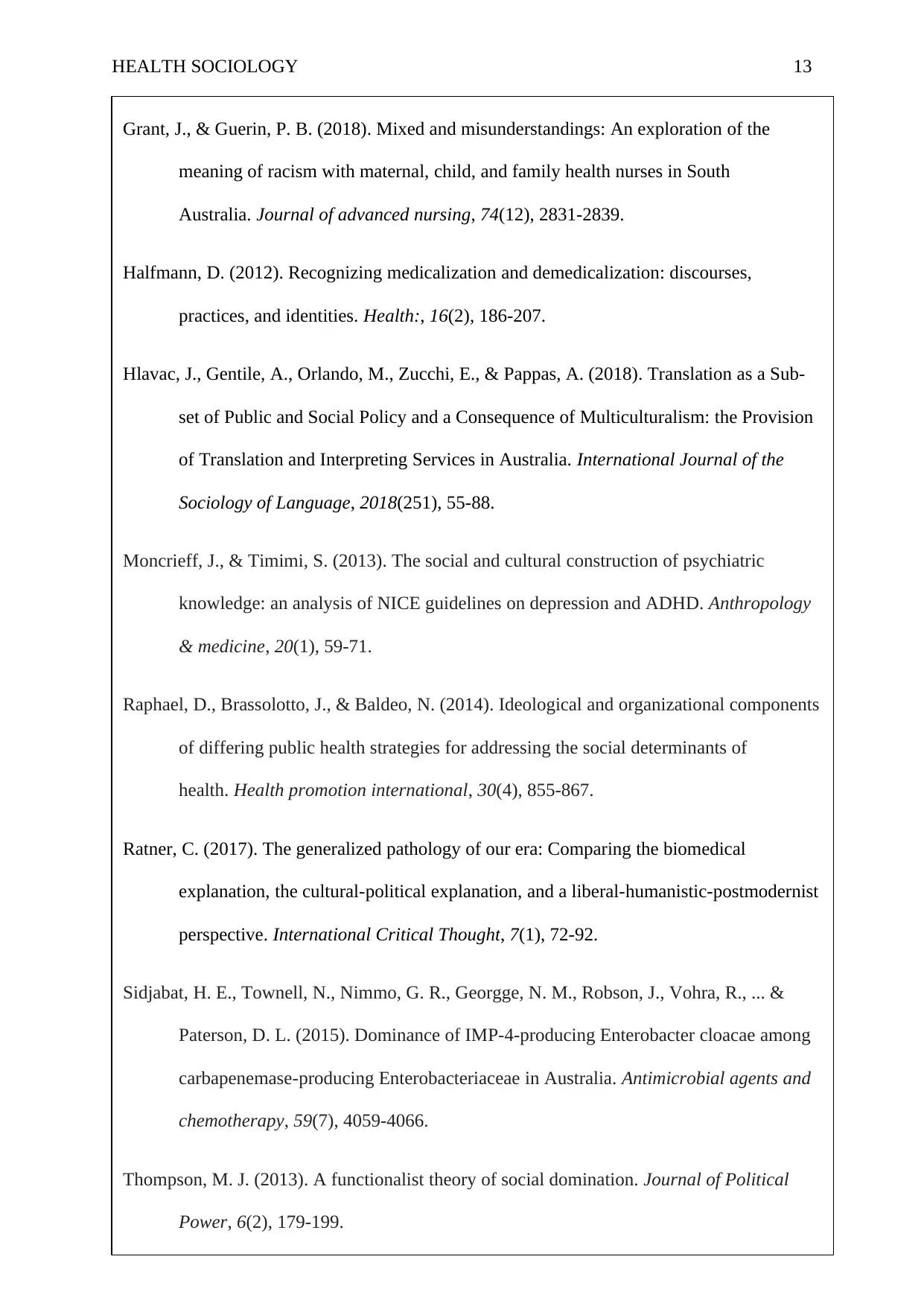
HEALTH SOCIOLOGY 13
Grant, J., & Guerin, P. B. (2018). Mixed and misunderstandings: An exploration of the
meaning of racism with maternal, child, and family health nurses in South
Australia. Journal of advanced nursing, 74(12), 2831-2839.
Halfmann, D. (2012). Recognizing medicalization and demedicalization: discourses,
practices, and identities. Health:, 16(2), 186-207.
Hlavac, J., Gentile, A., Orlando, M., Zucchi, E., & Pappas, A. (2018). Translation as a Sub-
set of Public and Social Policy and a Consequence of Multiculturalism: the Provision
of Translation and Interpreting Services in Australia. International Journal of the
Sociology of Language, 2018(251), 55-88.
Moncrieff, J., & Timimi, S. (2013). The social and cultural construction of psychiatric
knowledge: an analysis of NICE guidelines on depression and ADHD. Anthropology
& medicine, 20(1), 59-71.
Raphael, D., Brassolotto, J., & Baldeo, N. (2014). Ideological and organizational components
of differing public health strategies for addressing the social determinants of
health. Health promotion international, 30(4), 855-867.
Ratner, C. (2017). The generalized pathology of our era: Comparing the biomedical
explanation, the cultural-political explanation, and a liberal-humanistic-postmodernist
perspective. International Critical Thought, 7(1), 72-92.
Sidjabat, H. E., Townell, N., Nimmo, G. R., Georgge, N. M., Robson, J., Vohra, R., ... &
Paterson, D. L. (2015). Dominance of IMP-4-producing Enterobacter cloacae among
carbapenemase-producing Enterobacteriaceae in Australia. Antimicrobial agents and
chemotherapy, 59(7), 4059-4066.
Thompson, M. J. (2013). A functionalist theory of social domination. Journal of Political
Power, 6(2), 179-199.
Grant, J., & Guerin, P. B. (2018). Mixed and misunderstandings: An exploration of the
meaning of racism with maternal, child, and family health nurses in South
Australia. Journal of advanced nursing, 74(12), 2831-2839.
Halfmann, D. (2012). Recognizing medicalization and demedicalization: discourses,
practices, and identities. Health:, 16(2), 186-207.
Hlavac, J., Gentile, A., Orlando, M., Zucchi, E., & Pappas, A. (2018). Translation as a Sub-
set of Public and Social Policy and a Consequence of Multiculturalism: the Provision
of Translation and Interpreting Services in Australia. International Journal of the
Sociology of Language, 2018(251), 55-88.
Moncrieff, J., & Timimi, S. (2013). The social and cultural construction of psychiatric
knowledge: an analysis of NICE guidelines on depression and ADHD. Anthropology
& medicine, 20(1), 59-71.
Raphael, D., Brassolotto, J., & Baldeo, N. (2014). Ideological and organizational components
of differing public health strategies for addressing the social determinants of
health. Health promotion international, 30(4), 855-867.
Ratner, C. (2017). The generalized pathology of our era: Comparing the biomedical
explanation, the cultural-political explanation, and a liberal-humanistic-postmodernist
perspective. International Critical Thought, 7(1), 72-92.
Sidjabat, H. E., Townell, N., Nimmo, G. R., Georgge, N. M., Robson, J., Vohra, R., ... &
Paterson, D. L. (2015). Dominance of IMP-4-producing Enterobacter cloacae among
carbapenemase-producing Enterobacteriaceae in Australia. Antimicrobial agents and
chemotherapy, 59(7), 4059-4066.
Thompson, M. J. (2013). A functionalist theory of social domination. Journal of Political
Power, 6(2), 179-199.
1 out of 13
Your All-in-One AI-Powered Toolkit for Academic Success.
+13062052269
info@desklib.com
Available 24*7 on WhatsApp / Email
![[object Object]](/_next/static/media/star-bottom.7253800d.svg)
Unlock your academic potential
© 2024 | Zucol Services PVT LTD | All rights reserved.